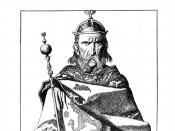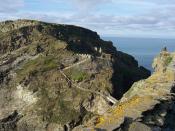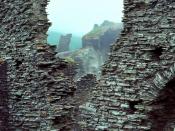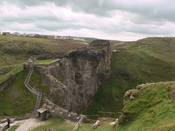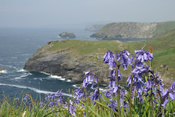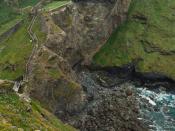Castles are more than just fortified structures. They are the beginning and end to civilizations and they are also where legends are made. A castle is a private residence of a lord. Castles were designed to be protected against knights and other foreign enemies. One of the most legendary castles was Tintagel. Tintagel Castle was most known for the location of where it was built, excavations, and its historical significance.
Tintagel Castle is located on the north coast of Cornwall, England, set high on cliffs overlooking the sea. Tintagel is a combination of "din" and "tagell". The name Tintagel, translated, means "fort of the constriction or narrow entrance." Around 1230, a castle was built at Tintagel by Prince Richard, Earl of Cornwall and son of King Henry III. It is believed by many that there was another castle built before Tintagel by Earl Reginald around 1141. (Tintagel Castle)To understand the significance of Tintagel's early use by Roman and Celtic warriors, everyone needs to appreciate the severe impact that Mother Nature and a steady amount of erosion have had on the terrain around the castle.
Yearly a small amount of the castle will fall into the surrounding sea. Connected to the mainland by a narrow strip of land, the fortress was close to becoming an impenetrable island. Potential attackers could neither storm the compound in mass nor navigate a ship past the rocky perimeter. Perched several hundred feet above sea level, this area not only had a spectacular view of everything around it but also had the entrance to two shoreline caves that run beneath the isle itself. The larger of the two, is called "Merlin's Cave," where it was believed to be the hiding place of the wizard Merlin and where Merlin kept the newborn Arthur from potential harm from enemies of the Pendragon crown and throne.
According to Cornish legends the ancient Kings of Cornwall held their court at Tintagel Castle. The castle was built for propaganda purposes and had no real strategic value. It is often speculated that it was a summer residence for the rulers of Dumnonia. Although their main feasting hall has not been located it is thought to lay beneath the ruins of the medieval castle. The ruins Tintagel Castle is what one sees on the island today.
High on the jagged cliffs of England's southwestern coastline lay not only the remains of a long abandoned castle but the mythical birthplace as well of one of this country's most enduring legends, King Arthur. Many sites throughout the United Kingdom stake claims of association to the chivalrous knights of Camelot. Tintagel is the backdrop of both Alfred Lord Tennyson and Geoffrey of Monmouth's tales of star-crossed lovers.
When Geoffrey of Monmouth was writing in the 1100s, the 1230 Tintagel Castle would not have been there and legend would have been his main source of what had happened on the island stronghold. Geoffrey of Monmouth tells that near the end of Roman occupation in Britain, the Archbishop of London offered the throne of Britain to Constantine, as the country was suffering from Pict invasions. Constantine ruled for ten years and had three sons - Constans, Aurelius Ambrosius and Uther. Constantine was murdered by a Pict and the throne should have been handed down to Constans, the eldest son. An English noble, manipulated Constans and gained control of Britain. However eventually Aurelius Ambrosius, and Uther Pendragon reclaimed their rightful throne after the English noble. King Arthur, son of Uther Pendragon was born soon after, according to Geoffrey's account. (Legend of King Arthur)It was claimed by Geoffrey of Monmouth in the 12th century that the castle at Tintagel Head was where King Uther Pendgragon seduced Queen Igraine of Conwall, while her husband,Gorlois, was under siege elsewhere. Geoffrey of Monmouth's account makes Tintagel the fortress of Gorlois, husband of Igraine, the object of Uther Pendragon's desires. Merlin transformed Uther, so that he looked like Gorlois, and hence tricked Igraine into making love to him. King Arthur was the result of this clever scheme. Though this is the first reference that link's Arthur with Tintagel, Geoffrey may have been using earlier legends. Some scholars believe that Tintagel was Camelot itself. There are also legends that consider Tintagel as one of King Mark's strongholds, which further supports the site as having history as a Cornish stronghold. William of Worchester first recorded that King Arthur was born at Tintagel in 1478. (Tintagel Castle)Excavations at Tintagel in the 1930s unearthed a wealth about Tintagel Castle. More than twenty rectangular stone buildings were discovered on the eastern slopes. A significant amount of Mediterranean pottery, which possibly contained wine, oil, or was simply used for show, was also discovered. The presence of this pottery is known now as "Tintagel Pottery" because it is the largest concentration of such pottery in Britain. Such pottery found was Tunisian oil jars, Carthaginian dishes, Aegean amphorae and Byzantine jars. (Tintagel Castle) The finding of such expensive pottery indicates that Tintagel was ruled by an important leader with access to large amounts of tradable commodities of his own. It is assumed that Cornish Tin was used for exchanging goods. Such pottery has also been found elsewhere, notably at Cadbury Castle. This indicates the wealth of Tintagel in the 5th and 6th centuries, the time of Arthur. Historically it would appear that Tintagel was an important trading post from late Roman times until it was abandoned at the end of the 7th century.
A massive fire on the Island in 1985 gave an opportunity to survey the entire area. More than fifty buildings have now been identified. Further excavations on the eastern terraces showed that there are less stone buildings that exist on a lower level. Other buildings may have been made of wood or turf.
In 1483, the Chapel of Tintagel Castle, Chapel of St. Juliette, was still being used. The remainder of Tintagel Castle was ruined. Tintagel CastleÃÂs remains are meager, but the inner ward does contain the most substantial surviving masonry. The Great Hall stands to reasonable height and the North wall makes a striking picture against the coastline.
Within the Roman period, around 100 pieces of local Romano-British pottery dated between the 3rd to 4th centuries have been found at Tintagel. No other Roman site is present anywhere in this area with similar architecture or Roman pottery. The conjecture is that Tintagel was a trading post, and this is further pointed to by the presence of many Mediterranean and Gaulish imports from a slightly later period. They are mostly pottery of an age that suggests Tintagel was abandoned before the end of the seventh century.
It is also presumed that Tintagel was originally used as a Celtic Monastery. A collection of burials was found near the chapel and it was thought that these were the graves of saints that pilgrims came to visit.
An additional archeological find was made in July 1998 at Tintagel when researchers from Glasgow University exposed a sixth-century slab with this inscription: PATER COLI AVI FICIT ARTOGNOV. ÃÂThis has been translated to mean ÃÂArtognou, father of a descendant of Coll, has had this [building] madeÃÂ. The name ÃÂArtognouÃÂ was probably pronounced ÃÂArthnou.ÃÂ Art and Arth were fairly common prefixes to the names of Dark Age rulers.ÃÂ (Legend of King Arthur) The stone is probably confirmation of that Tintagel was a wealthy Dark Age stronghold. It confirms that there were relatively well-educated and wealthy people there in the sixth century with a name that may have sounded like Arthur. It does not prove that King Arthur himself lived at Tintagel.
There is also tale of ArthurÃÂs Footprint being found at Tintagel on the highest part of the island. The imprint is a small eroded hollow, the base of which resembles a footprint. An old tradition says that Arthur left his imprint in the rock when he stepped at one stride across the sea to Tintagel Church.
Therefore, Tintagel was a fairly significant site in the British Isles, with unusual trade with Roman and Mediterranean merchants. Whether King Arthur was born there or not is impossible to tell, but archaeological evidence does make Tintagel a reasonable site for such a kingdom at the supposed time of King Arthur. The unique artifacts at Tintagel emphasize its dominance as a royal kingdom and Mediterranean contact during the 5th and 6th centuries. There is 1500 years of years of history and legend surrounding the ruins of Tintagel Castle. After all the discoveries and excavations the mystery and purpose of this castle still has not yet been established.
BibliographyÃÂArthurian Adventure.ÃÂ
Heydt, Bruce. ÃÂTintagel.ÃÂ British Heritage March 1998. Ebsco. La Vernia HighSchool Library, La Vernia, TX,
